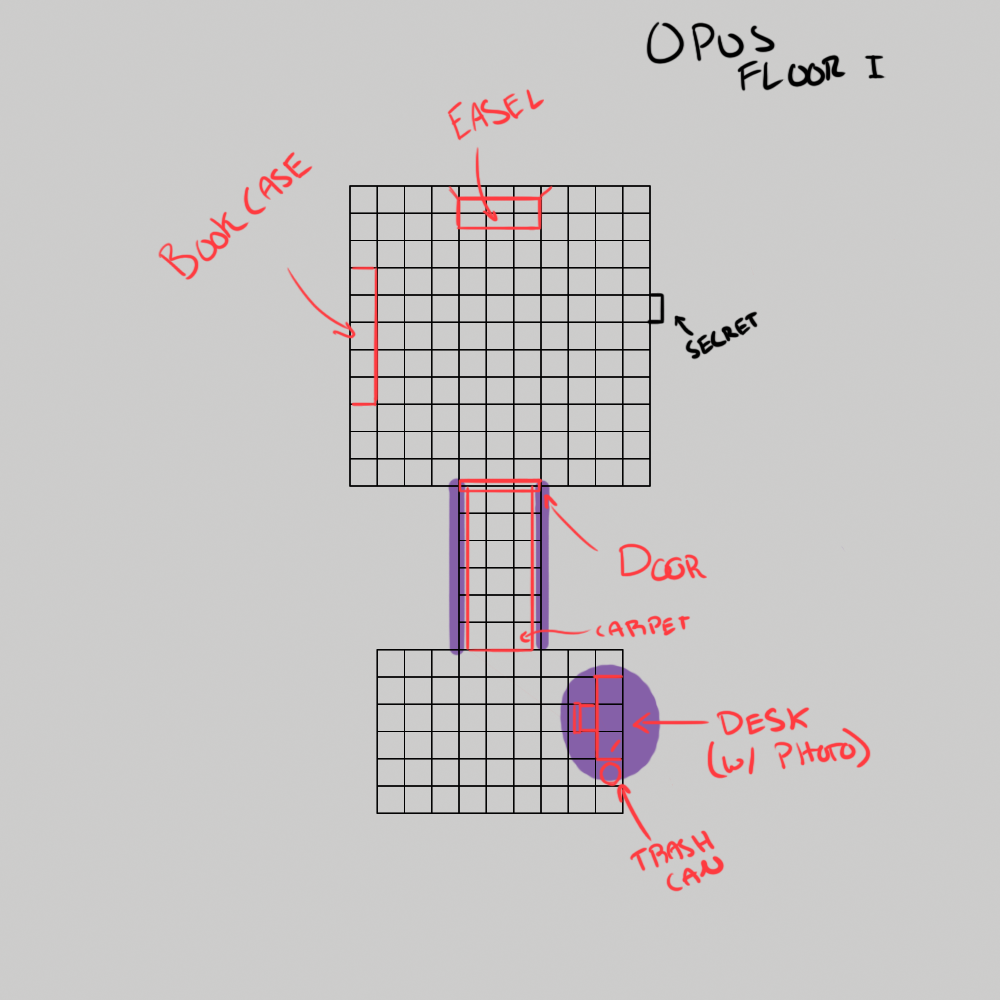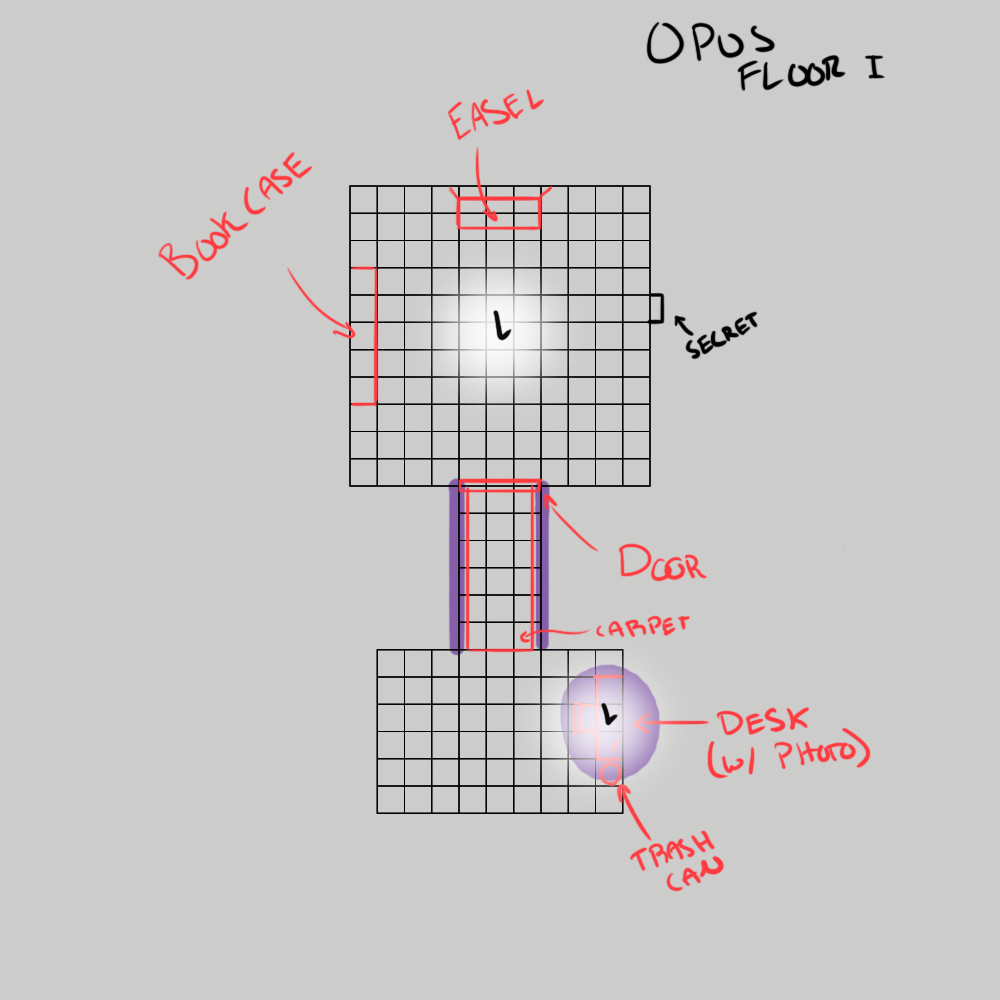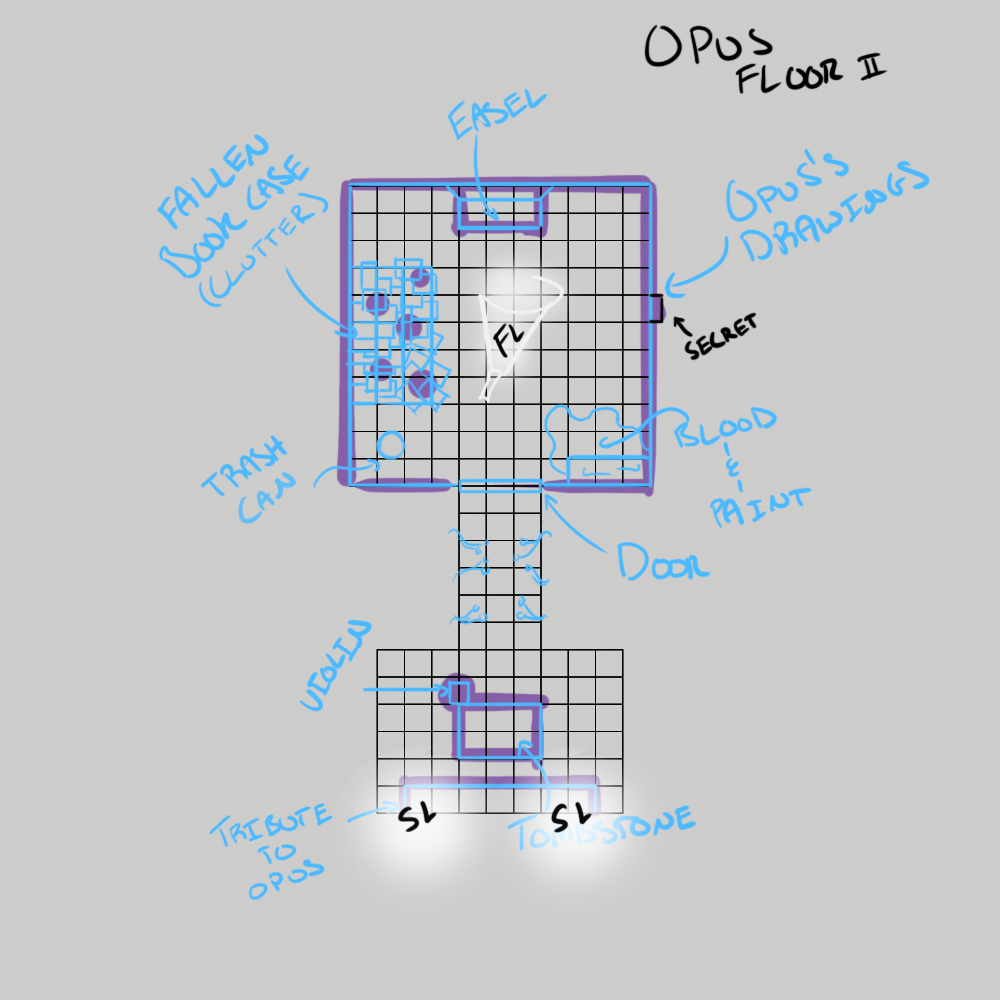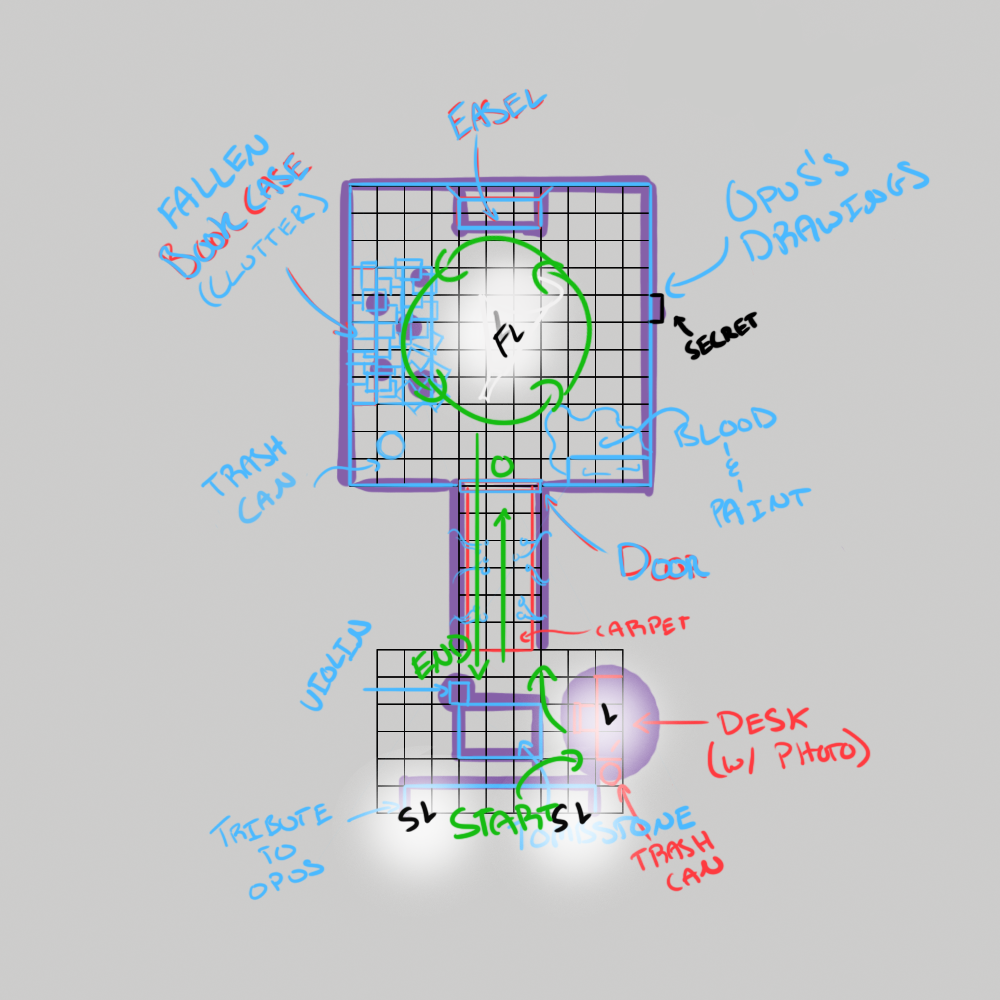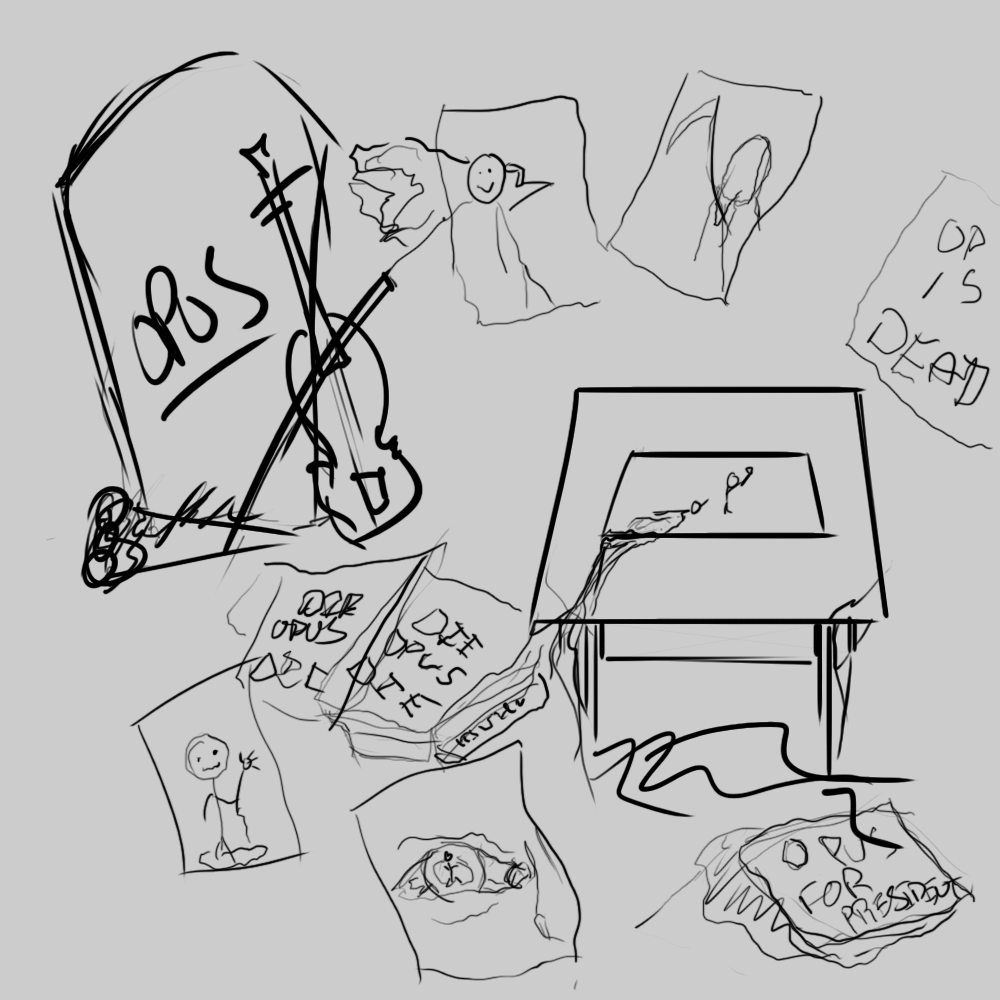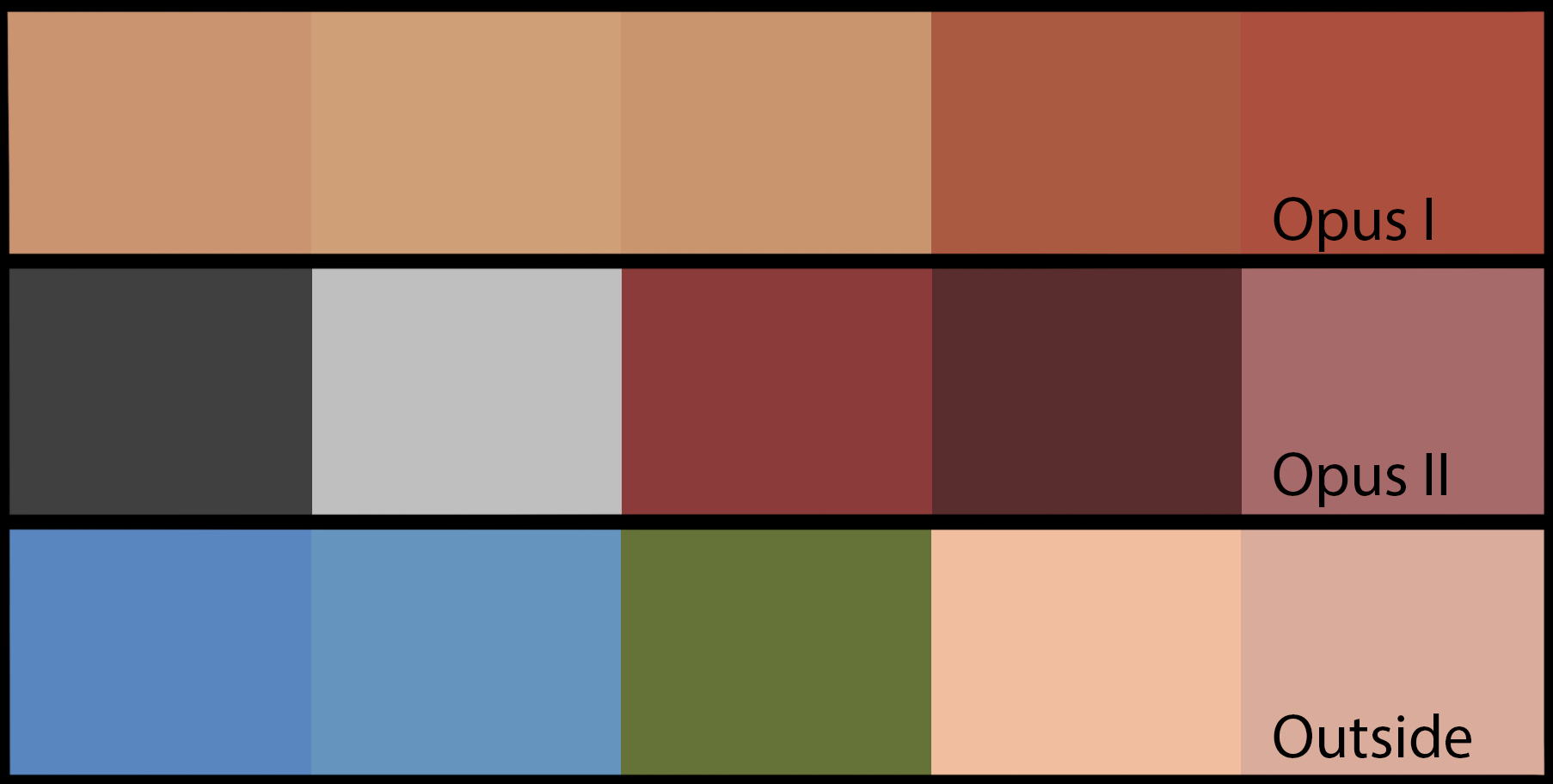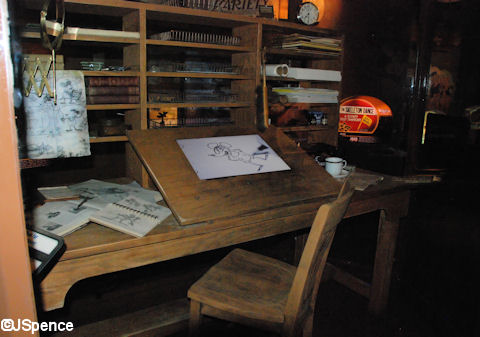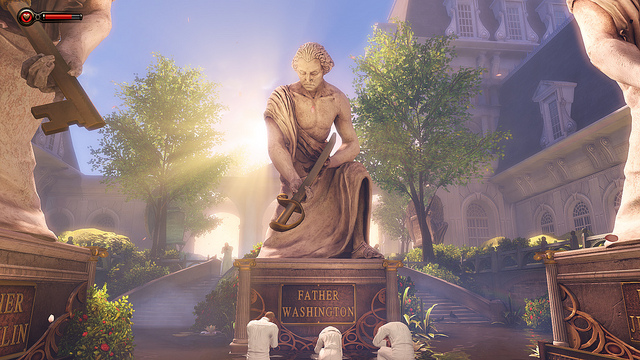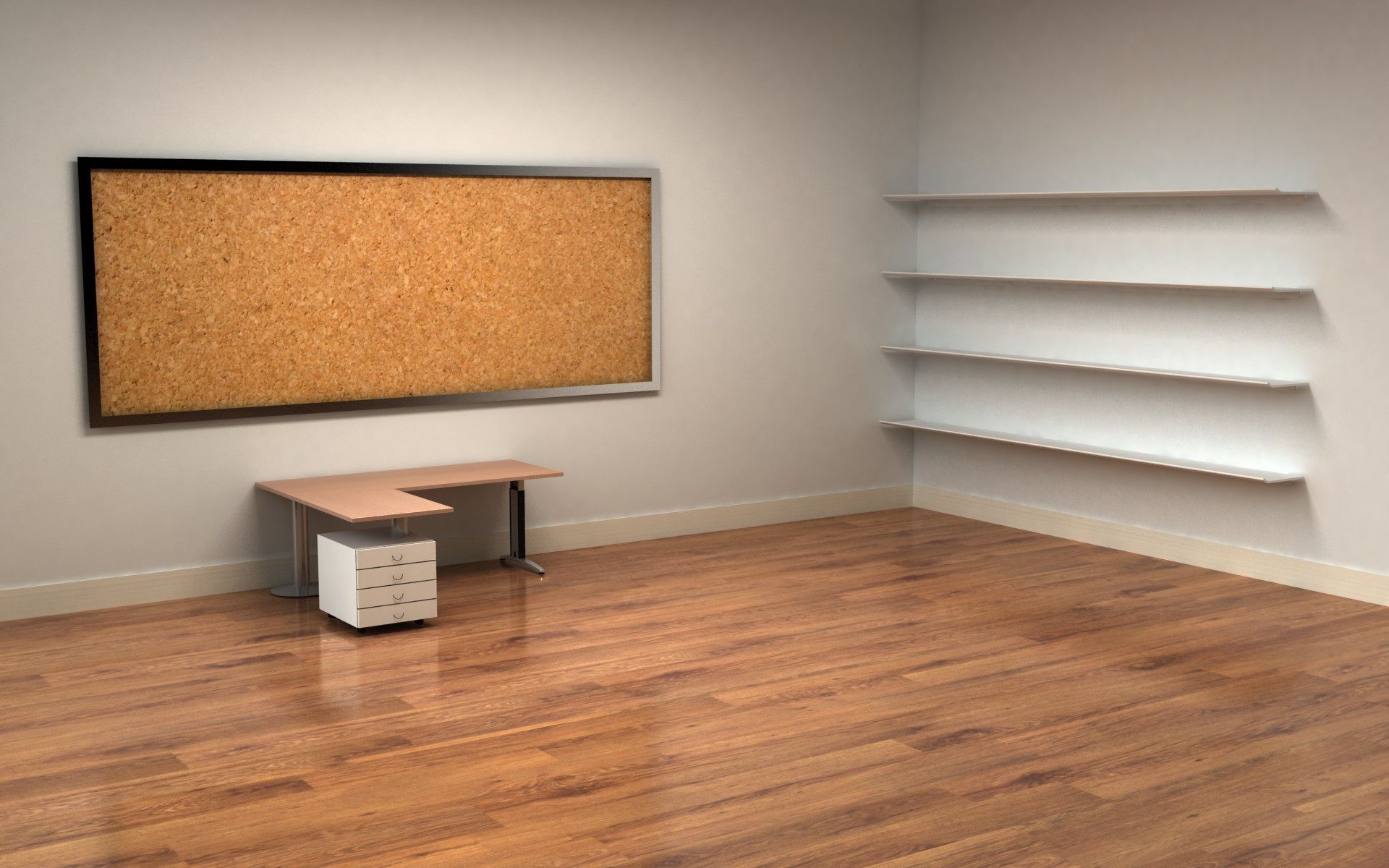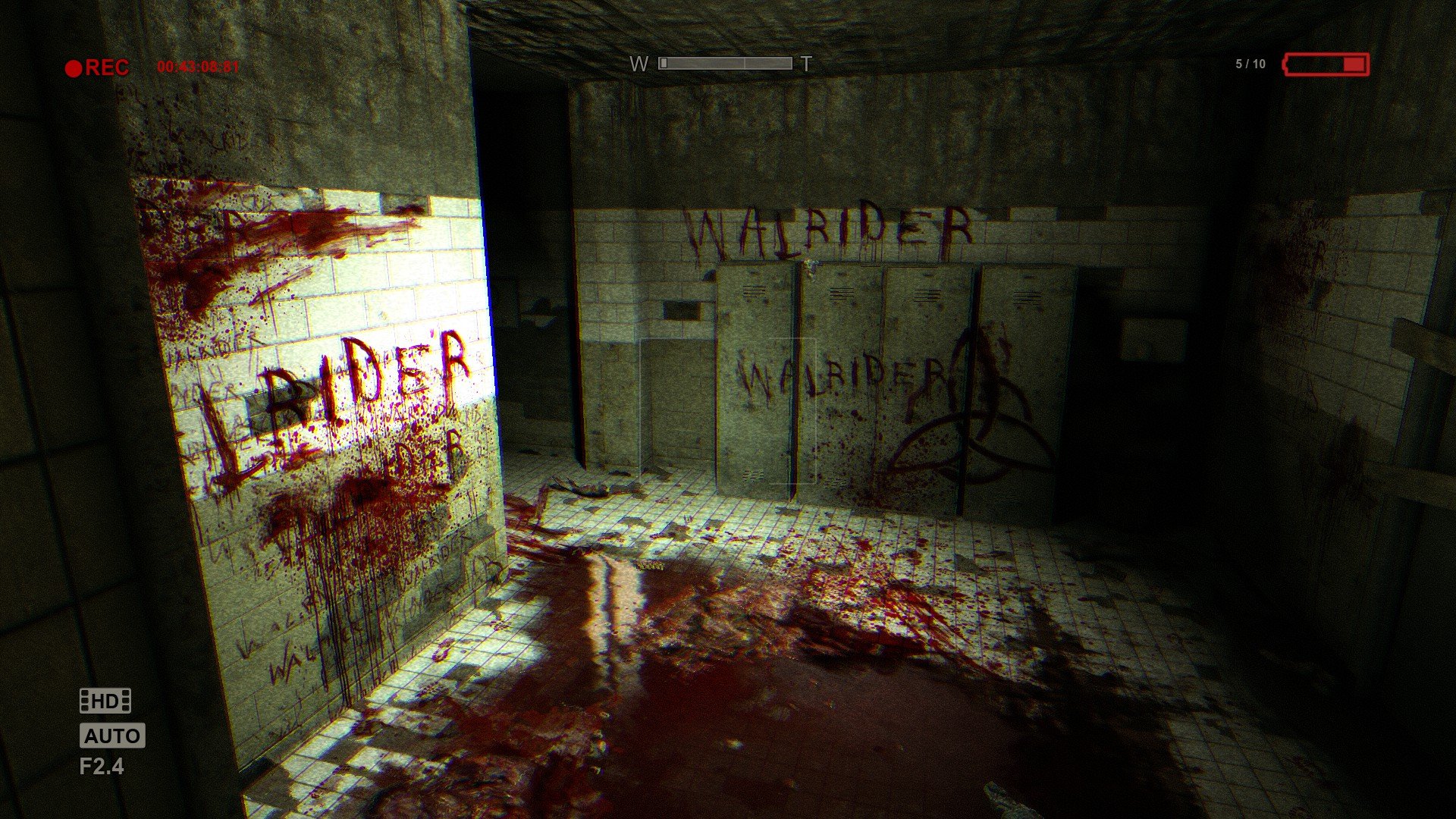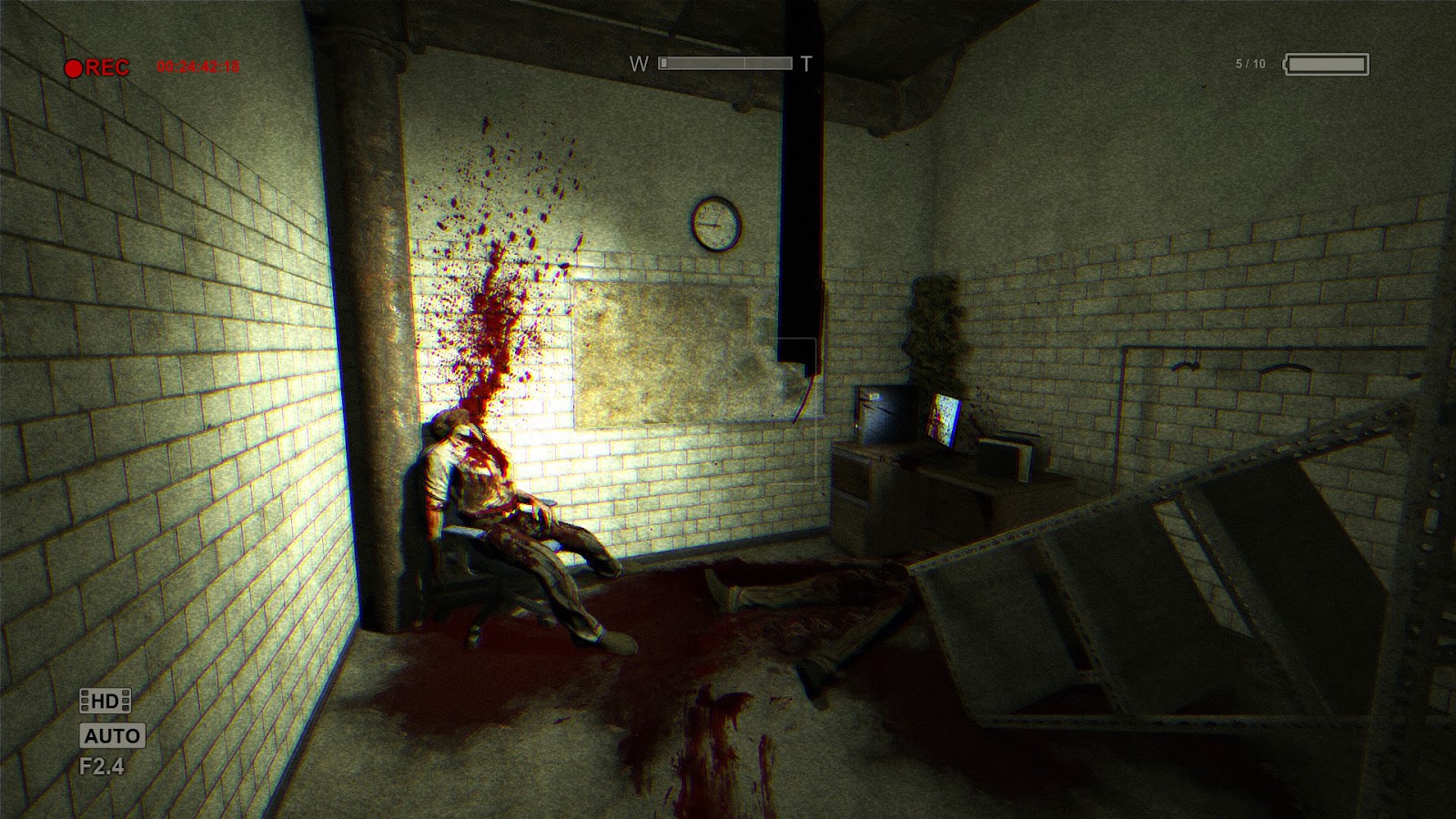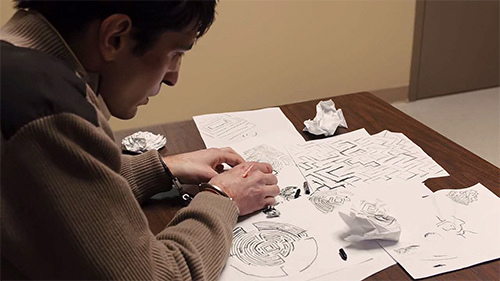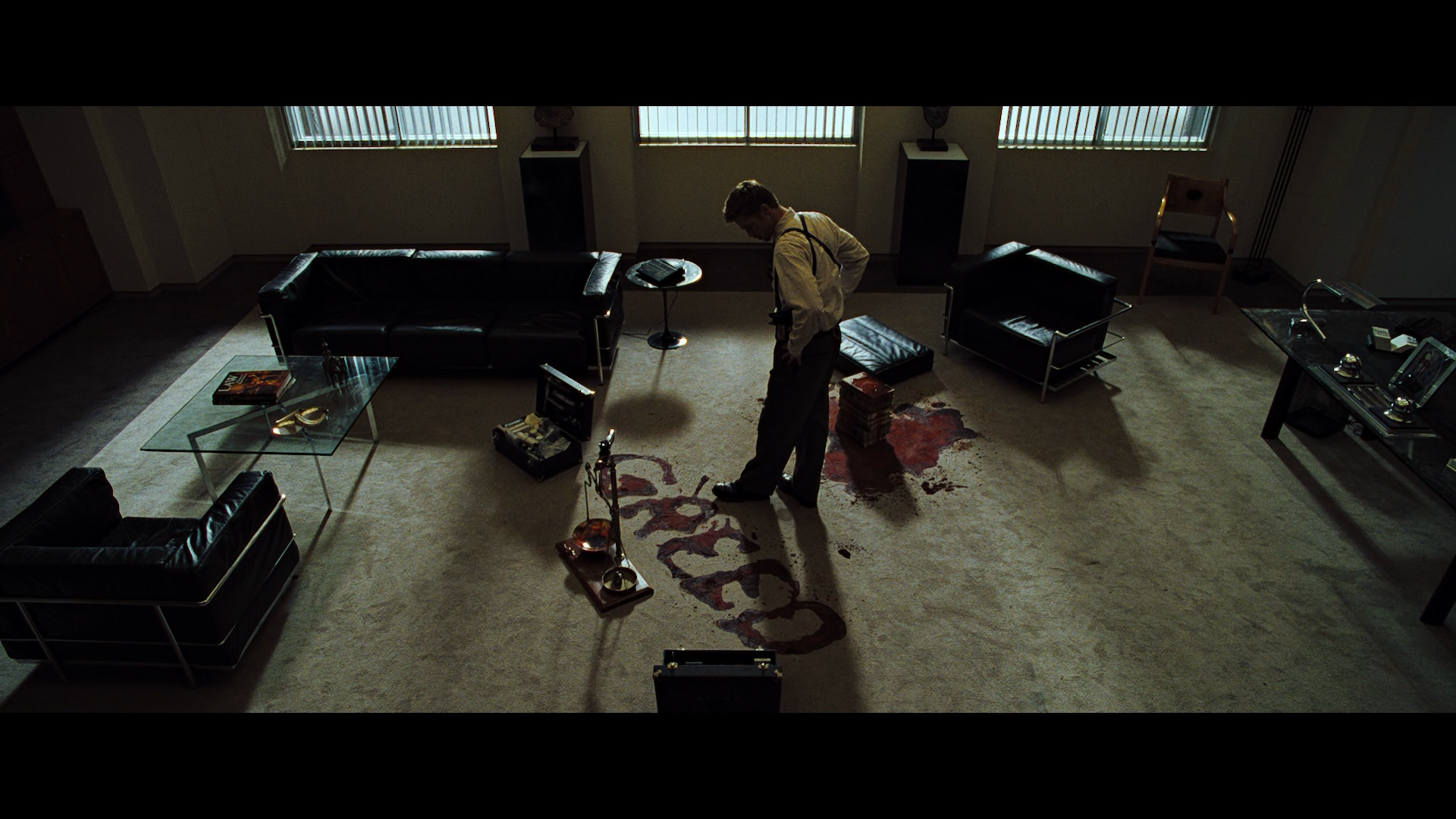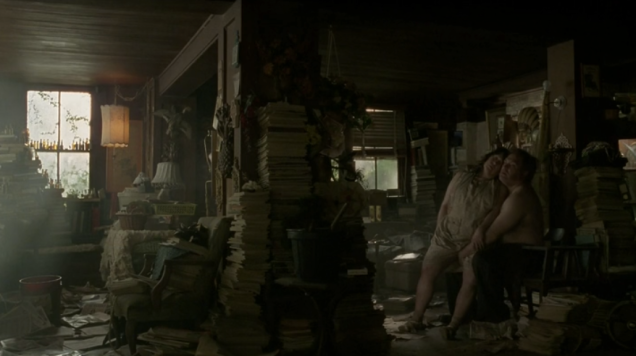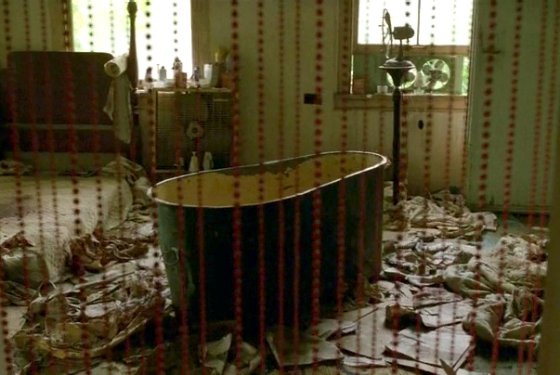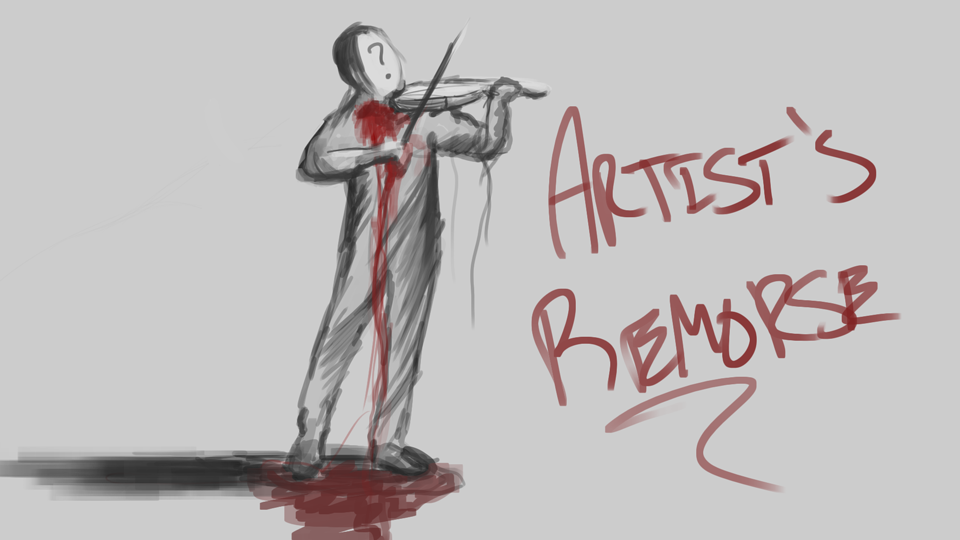I’ll discuss whatever issues there seems to be in class.
All posts by Sean McCarthy
Unity Midterm Check-In [Opus]
Below are several screenshots from my level. Much of the actual texturing is far from perfect, but these screens give a proper representation of an asset’s location[s] in the level. I have been weary of proper modeling and UV mapping techniques to present an ineresting environment. That being said, the floor and most of the wall textures are placeholders for a darker look. Further, the lighting is far from final.
Artist’s Remorse – Preproduction [Opus]
Artist’s Remorse – The Grid [Opus]
EDIT: Click the pictures to see the full grid. For some reason, the resizing takes out a grid line.
Artist’s Remorse’s level design is compact and decidedly busy in regard to how it handles the grid. The grid holds everything together and is home to two separate renditions of the Opus Level. Below is a look at the grid in its simplest form. As I go along, I will add information until everything is on top of each other, making it a confusing mess.
Opus Grid:
Now below this is the Opus Grid with the first iteration/part of the level. I’ve decided to call this Opus I.
Originally, it was my intention to introduce control of the detective to the player after making it completely inside the room. So, there really was only ever supposed to be the 11×11 square grid. After the added requirement of there being an outdoors scene, I added a little extra to the story. Take a look at Opus I; the red represents objects on the floor, while the purple areas represent hot zones for the player. The bottom room in Opus I is supposed to be boring, yet hold some key bits of information to possibly foreshadow the first event. With the introduction of lights in the scene, you begin to have a sense of what the flow should look like in the level.
The first event is triggered when the player is able to completely see Opus I. After obtaining the information from the desk and the walls on the to the door, the detective/player may enter. Only for a short moment does the player see the room before the Opus haunting begins. During this event, the door closes and the detective must pull out his flashlight. The player is now standing in Opus II, seen below with lights and hot zones.
When Opus II is becomes “active,” the player may now begin their investigation. Notice the fallen bookcase and addition of the trash can and pool of blood. Opus I is a presentation of the room one month before the suicide occurs, while Opus II is the room the day the detective enters Opus’s home.
Nothing is final at the moment, the bookcase and similar changes are to conceptualize the transition from Opus I to Opus II.
With the walls completely covered in hot zones, the flow starts to turn into itself. The player will have to make more than one pass around the room to solve the puzzle. Inspecting the drawings will lead the player to learn more about Opus’s life before he trapped himself in his room, along with how his mind mutated and deformed as he suffered severe depression and malnourishment.
Once the player has solved the puzzle and saved Opus’s soul, the haunting will end and the door will open. As I said earlier, it was originally only supposed to be Opus’s room, but now the player, may actually leave the room to do a little extra investigating. The door opens to the outdoors, a stone step leading to Opus’s gravestone with his violin leaning against it. Behind the headstone, there is a wall covered in a tribute to Opus and his life before his depression took him away from the world.
I’m holding out on the story of Opus, so there is a little more wonder when I am able to present the level to the class.
And to give you a big mess, here is the grid with all of the objects, lights, and hot zones, with the flow lines to boot:
Modular Design:
Because the level is so small, there will be limited modular design. The most important element of the level is the number of drawings pinned all over the walls. The drawings will either be projected onto the walls or onto sheets of crumpled, paper. Below is a simple, yet dark concept of the design in Artist’s Remorse.
Color Swatches:
Reference Images:
WARNING [To those with weak stomachs, there is some grotesque imagery below]
Artistic Game Development – Artist’s Remorse [Opus]
Level Design [Word Doc]
The numbers coorelate with the list of items in the word file linked in the article we were assigned to read on worldofleveldesign.com.
Artistic Game Development I – Level Concept and Story
- Single Player
- Survival, Puzzle
- ADG I Level Design
Story:
- An artist performs his own coup de grace after a run in with depression. The real world had pressured him from every direction, leaving him to lock himself in his studio. In his last month, he created his final work, a projection of his internal struggles. Branching from his easel, the studio’s walls are stained with dark images, suggesting a more maniacal outlook on the world surrounding him.
Detective Clark enters the room to begin investigating the suicide of Mr. Opus. Curiously, a gust of wind closes the door behind him. A quick check of the door confirms the detective’s suspicion. Locked. With an attempt to force the door open, the abrasive sound of a violin’s twang cuts the silence.
- Turning around, Clark flicks his flashlight on, as he reaches for the light switch. A flash of light and the bulb blows just as quickly. Stepping slowly into the room, the player is soon introduced control of Clark. And it becomes the player’s goal to experience the haunting of Mr. Opus while discovering what led him to slice his own throat. Hidden in his drawings are the answers. Meanwhile, Mr. Opus continues to play the violin for the detective.
- The drawings stretched across the room direct the player’s investigation and Mr. Opus has somehow set up some dead ends. His mind even became a puzzle to himself, so unlocking the truth of his death becomes ever more confusing as the player tries to put the pieces together. Only when solving the puzzle does Mr. Opus’s music stop and the door opens.
Gameplay:
- The objective of the level is to discover the reason(s) for Mr. Opus’s suicide.
- From above, much of the information will be lost, as the drawings are cast along the walls, along with the answers to guide the detective out of the artist’s studio. It is for that reason that most concept art will be shown from the player’s first person perspective.
- The entirety of the level is one puzzle. Actually departing from the room may become second to the player’s priorities as he/she is lost in Mr. Opus’s story.
- Because this is a study of artistic design, much of the gameplay elements will be lost without the slightest bit of programming. That being said, the level will be staged up until the player believes to have solved the puzzle of the suicide. In the end, it is the interaction with the artistic surroundings that becomes the core gameplay.
- I want to give the player the chance to examine the room and Mr. Opus’s drawings for around a half hour. With the inclusion of red herrings, the player could be lost for longer.
- The level is not big, but will include a vast amount of information, including Mr. Opus’s life before the depression set in, along with what led him to his last month of cruel living.
- My audience is the crowd that is prepared for less of a game and more of an interactive story.
- Mr. Opus’s studio will be remembered as an unsettling invasion of another man’s life. The player will instantly feel as if he/she has imposed upon the darkest trenches of depression and death.
Visuals:
16/17. I am mostly inspired by the serial killer’s home in the show True Detective. The room’s unsettling displays of death, bloodlust, and depression will feel claustrophobic, as the player is constantly looking to each wall for answers. Everything begins to close in on itself.
19. At first, with the introduction of Mr. Opus’s ghost in the room, a suspenseful atmosphere is cast on the studio. As time passes though, the player will realize that the ghost is not a threat, but trapped in his own pit of despair, walls crawling with images of confusion and a lost mind.
20. Exploration will reward the player with more information about Mr. Opus’s story.
21. Though the drawings will feel so disconnected from each other, the player will discover that there is harmony in a number of them. All of the images will have something to say about Mr. Opus before and after the depression/suicide, as well.
22. I want to concentrate on artistic storytelling by creating a fulfilling atmosphere.
![Screenshot_2[Opus]](http://www.joshuarosenstock.com/teaching/IMGD3500_A14/wp-content/uploads/2014/09/Screenshot_2.png)
![Screenshot_1[Opus]](http://www.joshuarosenstock.com/teaching/IMGD3500_A14/wp-content/uploads/2014/09/Screenshot_1.png)
![Screenshot_5[Opus]](http://www.joshuarosenstock.com/teaching/IMGD3500_A14/wp-content/uploads/2014/09/Screenshot_5.png)
![Screenshot_4[Opus]](http://www.joshuarosenstock.com/teaching/IMGD3500_A14/wp-content/uploads/2014/09/Screenshot_4.png)
![Screenshot_3[Opus]](http://www.joshuarosenstock.com/teaching/IMGD3500_A14/wp-content/uploads/2014/09/Screenshot_3.png)

